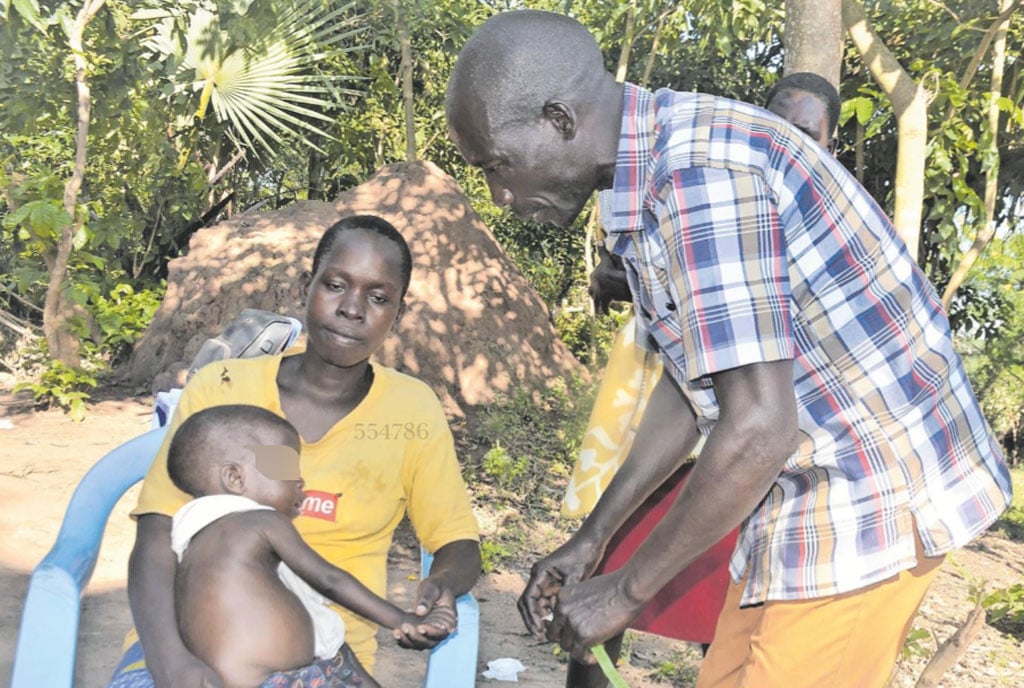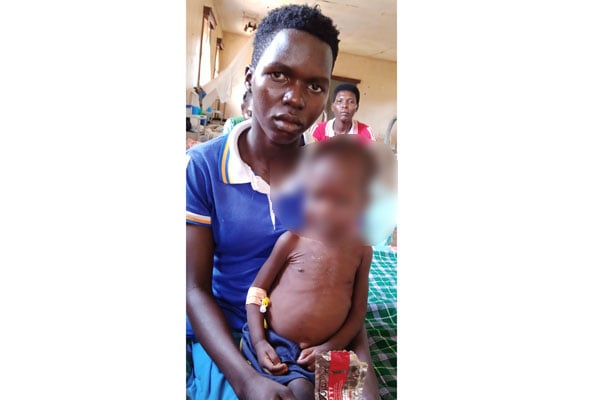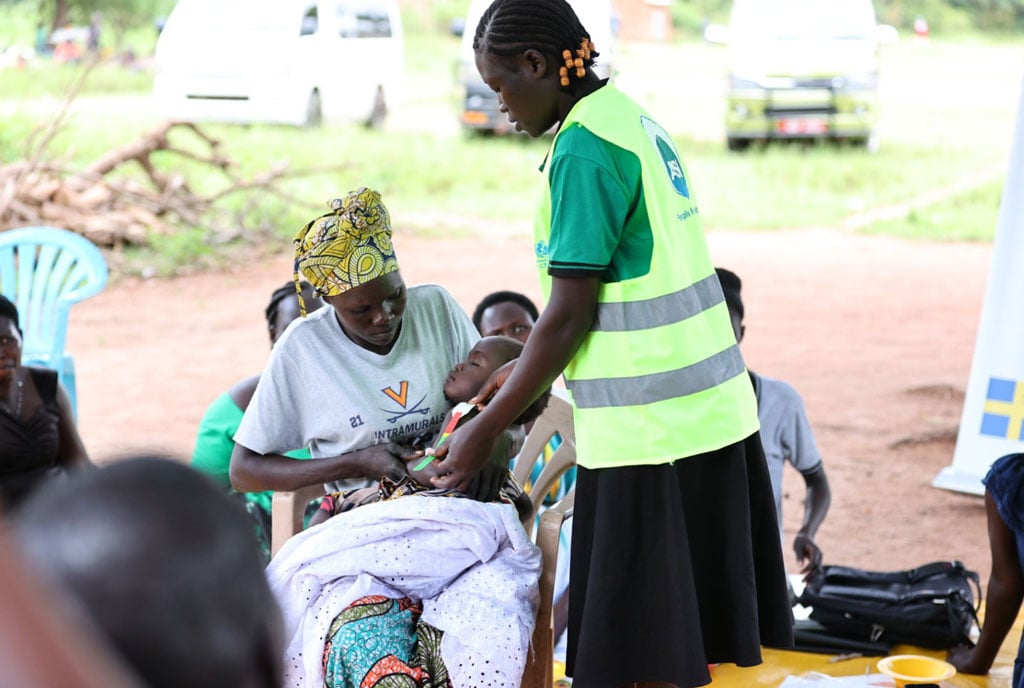
Paul Giira, the coordinator Village HealthTeam (VHTs) members in Alito Town Council, Kole District, assesses 3-year-old Daniel Ongom on October 13, 2024. PHOTO/JANE NAFULA
At three years old, Daniel Ongom weighs only seven kilogrammes and is unable to walk!
The flaccid legs, sunken eyes, and bulging belly are a testimony that he is battling severe malnutrition, a health condition that affects millions of children in Uganda, a country that is considered to be a food basket for a host of countries.
According to the child growth standards of the World Health Organisation, a three-year-old child is expected to weigh about 20 kilogrammes for boys and 21 for girls.
Ongom’s youthful mother, Ms Immaculate Amongi, 20, who is expecting her second child, has always been convinced that her son’s condition was caused by witchcraft.
Last month Ms Amongi attended a gender and nutritional training conducted by child nutritionists at a model home in Alito Town Council, Anenober Village in Aketo Parish in the northern district of Kole, where Ongom and several other children were assessed for malnutrition.
“I thought he had been bewitched. But today, I have been told that his body lacks the required nutrients,” Ms Amongi beams with excitement as she shares the news.
When asked what she feeds her child, she responds assertively: “I do not prepare any special meal for my son, but instead, feed him on boiled cassava and pigeon peas, a delicacy that is served to the rest of the family members when they return from the garden between noon and 1pm.”
Like Ms Amongi, Ms Grace Nakato Nakibuuka’s nine-month-old son is also battling the same condition.
The 28-year-old mother of five from Kitanzige Village in Lwamata Sub-county, Kiboga District says she feeds her son porridge made out of cassava flour since she cannot afford milk sold by local vendors, at Shs500 per cup.
She adds that a friend told her that both milk and cassava porridge contain the same food values since they are both white in colour.
Ms Samalie Namusoke, the assistant commissioner of the Nutrition Division in the Ministry of Health, blamed the issue on food insecurity, repeated infections triggered by poor health seeking behaviour, poor breastfeeding patterns, poverty and lack of safe water and sanitation, among others.
“There has been a reduction in stunting because when we look back, stunting stood at 45 percent, we went on reducing to 35 percent, 29 percent, and it is now at 26 percent. So, there is some decline, although it's not really what we want and there are many reasons,” she said.
“One is that there are some regions that are prone to food insecurity. Karamoja has consistently pulled down our performance because of the high number of those who are food insecure,” she explains.
She adds: “When you also add some of these calamities and emergencies, they aggregate the problem. But in some communities, we may actually have poor health-seeking behaviour. When one is sick and doesn't get the attention that is necessary, then of course, that compromises their nutrition status.”
Ms Namusoke observed that some communities are infested with worms.
“Children are not being dewormed. Worms keep eating all the food, affecting our nutritional status. That's why we have a high prevalence of congenital anaemia,” she said.
Ms Namusoke also notes that in some communities, mothers don't give children the attention that is required and leave them under the care of their siblings and maids.
She said such parents never bother to find out whether the baby has eaten the right amount of food.
According to her, Karamoja Sub-region bears the brunt of malnutrition due to chronic food insecurity, followed by Tooro where most babies are fed one type of food (matooke).
Uganda Nutrition Action Plan II 2020/2021-2024/2024 shows that the distribution of stunting in children under five stands at 40.6 percent in Tooro, 35.2 percent in Karamoja, 35.9 percent in Bugisu, 34.5 percent in Bunyoro, 33.9 percent in West Nile, 30.8 percent in Kigezi, 30.6 percent in Acholi, 29.3 percent in Ankole, 29.0 percent in Busoga, 28.1 percent in North Central, 26.5 percent in South Central, 22.8 percent in Bukedi, 18.1 percent in Kampala, and 14.8 percent in Teso.
In addition, the population of children under five years who are wasting is 10.4 percent in West Nile, 10 percent in Karamoja, five percent in Lango and Bugisu, 3.9 percent in Kampala and Acholi, 3.7 percent in Kigezi, 3.6 percent in Busoga, 3.4 percent in Toro 2.2 percent in Teso, 2.8 percent in Bukedi and 2.3 percent in Bunyoro, among others.
Knowledge gap
Mr Joseph Bbemba, the deputy country director of Sasakawa Africa Association, an organisation that promotes nutrition-sensitive agriculture among smallholder farmers in Uganda, believes that sensitising Ugandans to have a balanced diet using locally available food should be a deliberate effort by the government, targeting everybody.
“The issue of nutrition is a national issue because we have cases of malnutrition where children are severely stunted because they are not getting a variety of nutrients from different groups of food, but we also have those who over eat and are obese,” Mr Bbemba explained.
Uganda is among the 20 countries in the world with the highest burden of malnutrition and threatens to destroy a generation of children with more than two million under the age of five stunted, according to United Nations Children’s Fund (Unicef).

Margaret Akullo, who owns a model home in Ober Awer Parish in Alango Parish in Otuke District teaches people how to make nutritious food. PHOTO/JANE NAFULA
According to the 2023/2024 Annual Health Sector Performance, which was released by the Ministry of Health early last week, out of the 7,882,226 children under the age of five years in Uganda, stunting stands at 26 percent, wasting (low weight for height) is at 2.9 percent, underweight (too thin for age) 9.7 percent while the prevalence of obesity among children under five years is at 3.4 percent.
The World Health Organisation (WHO) defines malnutrition as deficiencies or excesses in nutrient intake, imbalance of essential nutrients, or impaired nutrient utilisation.
Undernutrition manifests in the form of wasting, stunting, underweight, and micronutrient deficiencies (lack of vitamins and minerals that are essential for body functions such as producing enzymes, hormones and other substances needed for growth and development).
According to Unicef, women tend to get pregnant when young and have low birth-weight babies, which predisposes them to malnutrition.
Uganda’s teenage pregnancy currently stands at 24 percent.
The global children’s body also notes that repeated childhood infections such as diarrhoea and low breastfeeding rates also lead to wasting and stunting or even death.
It also states that between 2013 and 2015, about 500,000 children succumbed to malnutrition.
Gender issues
Mr Bbemba notes that to achieve proper nutrition, both men and women should be helped to understand their roles in ensuring that the family is fed on a balanced diet.
“Communities don't know how to use the different foods to achieve nutritional needs. Once a man establishes a banana plantation, he thinks that is what food is all about,” he observes.
He adds: “Malnutrition has a gender perspective. Both men and women need to understand what nutrition is about, so that even when they are planning for the resources in their homes, they invest some money in foods that are not grown by the family.’’
Ms Namusoke, however, says the Ministry of Health has trained health workers in nutrition packages and ensured that they offer quality nutrition services to the communities.
She adds that the private sector is equally implementing a variety of interventions to address malnutrition challenges in the country.
Mr Bbemba says his organisation is piloting model homes in seven districts to act as centres where women of childbearing age, mothers, the elderly, and people living with HIV/Aids gather and learn about proper feeding, sanitation, and proper hygiene.
The model homes are currently being piloted in the districts of Mubende, Kiboga, Rakai, Isingiro, Otuke, Kole and Napak. The model homes also train mothers in making nutritional food for children.
Ms Margret Akullo, a 50-year-old widow who owns a model home in Ober Awer Parish, Alango Sub-county in Otuke District, says she has taught hundreds of women in her village to locally make composites using a mixture of millet flour, peanut paste, soybeans, and silverfish.
She also makes the same composite and sells the flour to those who are unable to do it.
Ms Akullo says a kilo goes for Shs5,000, while a cup of porridge made out of the composite costs Shs500.
Mr Festo Nsokwa, a health assistant in charge of Lwamata Parish in Kyekumbya Sub-county, Kiboga District, says the most critical time for good nutrition for a child is during the 1,000-day period from pregnancy until their second birthday.
Mr Nsokwa explains that this is because during the first 1,000 days, the brain grows faster than at any other time in a person’s life and a child needs the right nutrients at the right time to foster the development of a brain, a critical body organ that controls body functions.
Both the Ministry of Health and WHO recommend that infants should be fed on breast milk within an hour of birth, be exclusively breastfed for the first six months, and continue breastfeeding until two years of age or beyond.
They state that at six months, babies should be introduced to soft foods composed of a variety of food groups and should continue to be breastfed.
Mr Nsokwa says few families adhere to proper nutrition since most of them sell off almost everything that they produce at home or feed on one type of food.
Hiring out land and food insecurity
Mr Moses Ongom, an agricultural officer in Alito Town Council, Kole District, says some families are not able to produce enough food because they chose to rent out agricultural land.
“Families with small pieces of land are hiring from those who have, because of the growing population. However, there are drunkards who may own two acres and hire out all of them and remain with only the compound. They instead dig for people to earn a living and can hardly afford a balanced diet,” Mr Ongom says.
Mr John Patrick Odongo, the environmental health officer for Alito Town Council, says the local leadership is engaging clan chiefs to intervene so that clan members can be advised to desist from hiring out all the land.
Ms Paska Ajok, a crop production and management expert and a member of a model home in Kole District, says some families are so poor that when they lose someone, they have to sell land to raise money to cater for the funeral. The same happens when a boy needs a bride price to marry.
Ms Ajok however, says with the introduction of regenerative and market-oriented agriculture, some farmers are able to produce what is enough for home consumption and sell the surplus to cater for other family needs.
How to feed well
Ms Jacqueline Namusalisi, a technical coordinator of Nutrition Sensitive Agriculture at Sasakawa Africa Association and a nutritionist by profession, says the human body needs a variety of nutrients in certain amounts from different types of food (balanced diet) to maintain its tissues and its many functions.
“Once other foods are introduced at six months, parents need to give their children a good portion of carbohydrates because a child is expected to use a lot of energy when they are growing up. They need a portion of protein and fats for them to develop their muscles and also to be able to grow and replenish White blood cells that are wearing out and the general body functioning,” Ms Namusalisi explains.
These can be found in locally available foods like beans, mukene (silverfish), gnut paste, soya porridge, and potatoes, among other foods.
She adds: “The lipids are also good for the cells and the internal organs of the child, so we need a measurable proportion of some fat in the diet and then vegetables and fruits. You can encourage a child to eat a banana, an orange or jackfruit, a pawpaw, or any fruit that can be reached.”
Food safety
Ms Namusalisi advises food handlers to keep food clean and safe.
She explains that if food is contaminated with aflatoxin, the child will not have the required nutrients.
Ms Namusalisi, also stresses the need for parents to immunise and deworm their children, feed them frequently, and avoid early motherhood.
Health experts say children born to very young mothers are at increased risk of malnutrition, illness, and death than those born to older mothers.
WHO recommends exclusive breastfeeding for the first six months of life.
Exclusive breastfeeding is recognised for its significant health benefits, providing essential nutrients and antibodies that help protect infants from infections and diseases.
How to tell a child is malnourished
Ms Namusalisi says a child who is malnourished usually doesn't have a good appetite, grows slower than any other average normal child, and may grow tall and look thin with weak muscles.
Ms Namusalisi also explains that the hair of a child who is malnourished is usually brownish, the eyes are glassy and the skin is almost transparent.
She advised that if a parent or caretaker notices any of these signs, they should take the child to the hospital to receive timely medical care.
Impact
The World Health Organisation (WHO) says malnutrition increases healthcare costs, reduces productivity, and slows economic growth, which can perpetuate a cycle of poverty and ill-health. However, the global health body is working with member states and partners towards the goal of ending all forms of malnutrition by 2030 as part of the Sustainable Development Goals.






